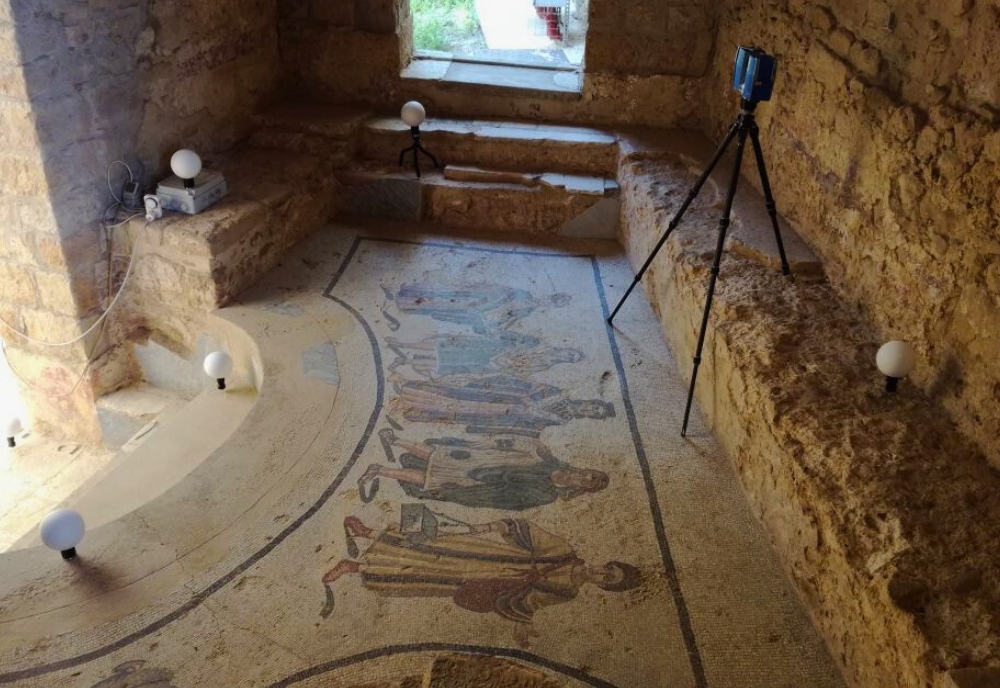Dr. Davide Tanasi, professor of digital humanities in the Department of History and director of the Institute for Digital Exploration (IDEx), received the John H. Oakley Lectureship from the College of William and Mary in Virginia.
He traveled to Virigina in September to deliver a lecture detailing the impact of 3D digitization on archaeological heritage and the global dissemination of knowledge.
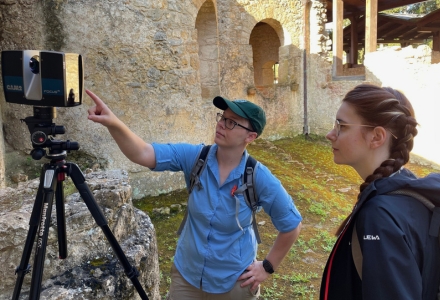
USF students and IDEx staff using terrestrial laser-scanning to digitize the kilns of the Villa’s bathhouse. (Photo courtesy of Dr. Davide Tanasi)
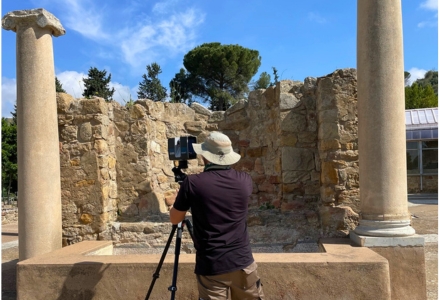
IDEx staff member using terrestrial laser-scanning to digitize the monumental entrance of the Villa (Photo courtesy of Dr. Davide Tanasi)
“My lecture, ‘From Ruins to (Virtual) Reality: The Digital Afterlife of the Roman Villa del Casale (Sicily),’ focused on a long-term remote sensing project launched by IDEx to 3D digitize and reassess via 3D visualization the complex of the Roman Villa del Casale at Piazza Armerina in Sicily, on the largest and most lavish villas in Roman history,” he explained. “Despite its significance, the site faces numerous challenges, including conservation issues, a limited understanding of its later use phases, untapped legacy data, and inadequate digital accessibility.”
Tanasi shared the potential of those digital methods to improve the global accessibility of Roman material culture, making this approach of invaluable importance to capture a wider audience, and how digital approaches are revolutionizing the perspectives of archaeologists and art historians on Roman villas, their decorative elements, and the artefacts they contain.
“In the context of this project, methodological best practices in 3D digital imaging and visualization have been employed to show their potential to enhance iconographic and architectural studies, monitor and document changes in the physical state of mosaics, recontextualize legacy data for more comprehensive analysis and offer virtual accessibility for the public with limited mobility and cognitive disabilities,” he added.
Tanasi added that there were numerous challenges to overcome for this 3D digitization, with the main challenge being a constant flow of visitors at the site.
“Averaging 450,000 visitors per year, the Villa del Casale is one of the most important
cultural heritage sites in Sicily and among the most visited. During our fieldworks
the site could not be closed and therefore we had to work around the people finding
technical solutions on the fly, turning that experience, though, into a moment of
public outreach on site that was very rewarding.”
Another challenge Tanasi had to overcome was, upon arriving back in Tampa, processing
the enormous volume of 3D data captured and generating the final 3D product models.
“The 5th century CE Villa del Casale is a paramount example of a late Roman rural villa, boasting 3500 m² of exceptionally well-preserved mosaic floors and a rich historical narrative. Thanks to this exceptionality, in 1997 the site was added to the Unesco World Heritage Sites list, bringing to a level of astounding international popularity. The sudden increase of touristic presence at the Villa gradually posed significant problems of conservation and accessibility that make it the best perfect case study for the application of 3D digitization and 3D visualization methods,” he said.
USF and IDEx have been in the forefront of advancing 3D digital scholarship for several years already, according to Tanasi, leading the academic community in designing and executing new research protocols for the digital preservation and communication of the global digital heritage.
“This project at the Villa del Casale of Piazza Armerina represents an example of best practices that likely will be adopted as a model for similar other endeavors,” he said.
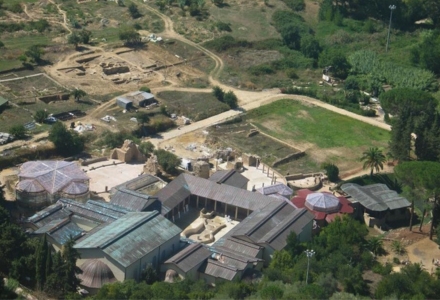
Aerial view of the Villa del Casale and its environs captured from a drone. (Photo courtesy of Dr. Davide Tanasi)
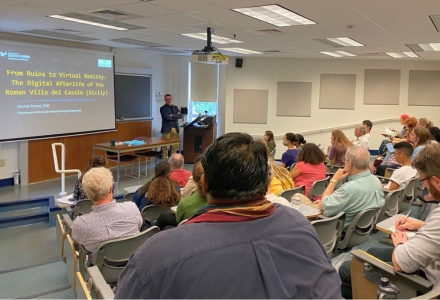
Dr Davide Tanasi delivering the 2024 John H. Oakley lecture at the College of William and Mary. (Photo courtesy of Dr. Davide Tanasi)
Alongside the digital project, based on application of remote sensing technologies, IDEx has also joined an international project to reopen, after a long gap, the excavation at the Roman Villa del Casale.
Three excavation campaigns, held in 2022, 2023, and 2024, to which IDEx members and USF students participated, have shed light on the afterlife of the Roman villa and the transformation of its area in a village in the Middles Ages.
The collective project is now called ARCHLabs - Archaeological Heritage in Late Antique and Byzantine Sicily.
“It means the world to me to have received this lectureship,” Tanasi said. “John H. Oakley is a leading scholar in ancient Greek Art and Archaeology, world renowned for his pioneering research on Greek vase painting, funerary practices, and iconography. His work has significantly shaped the field, offering fresh perspectives on Greek visual culture. Among his most influential publications, The Achilles Painter is a landmark study that redefined the understanding of one of Greece’s key vase painters, while Athenian Potters and Painters expanded interpretations of Athenian ceramics and their social significance. Oakley’s Picturing Death in Classical Athens provided a groundbreaking exploration of how art reflected Greek attitudes toward death and the afterlife. His scholarship continues to inspire and influence, setting high standards for research and interpretation in the study of ancient Greek art. I met him first in 2011 and since then he has been a great mentor and academic role model. To be featured in the lecture series in his honor, it matters greatly to me.”
Learn more about Tanasi’s research and IDEx.
